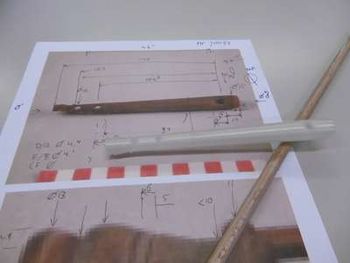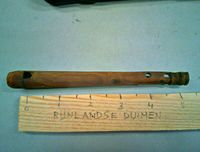ChildrensTaborPipe: Difference between revisions
New project |
m Shape of the block |
||
| (3 intermediate revisions by the same user not shown) | |||
| Line 3: | Line 3: | ||
|Picture=ChildrensTaborPipe.jpg | |Picture=ChildrensTaborPipe.jpg | ||
|Omschrijving=Reconstruction of a late medieval archaeological find | |Omschrijving=Reconstruction of a late medieval archaeological find | ||
|Status= | |Status=In progress | ||
|Contact=Molenaar | |Contact=Molenaar | ||
}} | }} | ||
| Line 17: | Line 17: | ||
After working out the measurements into a LibreCAD drawing, it was not difficult to make a 3D model in OpenSCAD and print it. This allows me to make a new block and tune the holes. The sound of centuries ago can be heard again! | After working out the measurements into a LibreCAD drawing, it was not difficult to make a 3D model in OpenSCAD and print it. This allows me to make a new block and tune the holes. The sound of centuries ago can be heard again! | ||
Update: the 3d printed version is now playable, but it sounds so high you will probably not make many friends with it. The block is very wedge-shaped, which was noticeable on the original find as well. When I measured the original, I thought this was a later add-on or repair, but I had to make my block equally wedge-shaped to guide the airflow through the labium (you want to blow ''over'' the pipe, not through it). It appears therefore that the block could be the original one after all. If you want to make a block for this instrument, make the block such that the upper plane of the clock coincides with the plane of the labium, and push the block just a tiny fraction too far in. | |||
My aim is to learn the technical difficulties and strategies for making this kind of instrument. Therefore, I want to make it on a [[Zweepdraaibank|pole lathe]], and when that succeeds, forge a spoon drill to make the bore of a another one. | My aim is to learn the technical difficulties and strategies for making this kind of instrument. Therefore, I want to make it on a [[Zweepdraaibank|pole lathe]], and when that succeeds, forge a spoon drill to make the bore of a another one. | ||
| Line 23: | Line 25: | ||
== Interesting Measurements == | == Interesting Measurements == | ||
The units used in Leiden from the early medieval times are the Rhineland units. They are still known (The city hall still features a rod to calibrate rulers). The note "A" usually had a length of one foot (12 Rhineland inches). The "A" on this instruments is three octaves higher, so would use a pipe of 12" / 2^3 = 1.5 inch. To reach this note, you have to overblow the instrument two times, so the wave is standing three times in the pipe. The pipe therefore needs to be 3 x 1.5 Rhineland inches for the note "A". You can see this length in | [[File:Meting_eenhandsfluit_4.jpg|200px|thumb|right|Measurement in Rhineland inches]] The units used in Leiden from the early medieval times are the Rhineland units. They are still known (The city hall still features a rod to calibrate rulers). The note "A" usually had a length of one foot (12 Rhineland inches). The "A" on this instruments is three octaves higher, so would use a pipe of 12" / 2^3 = 1.5 inch. To reach this note, you have to overblow the instrument two times, so the wave is standing three times in the pipe. The pipe therefore needs to be 3 x 1.5 Rhineland inches for the note "A". You can see this length in the distance between the centre of the blow hole and the second playing hole. This confirms that the instrument's lowest note is a "C", which is the perfect tuning for simple melodies in those days, like children's songs. | ||
Latest revision as of 14:58, 3 April 2019
| Project Children's Tabor Pipe | |
|---|---|

| |
| Reconstruction of a late medieval archaeological find | |
| Status | In progress |
| Contact | Molenaar |
| Last Update | 2019-04-03 |
An Archaeological Find
The tabor pipe is a recorder that is played with one hand only. Clamped between the pinky and index finger, the other fingers can cover the three holes. The instrument was usually played in combination with a drum. This combination was called the "Pipe and Tabor". The original find from the Groenesteeg in Leiden is missing a part of the back, so just a small part of the thumb hole remains if you know where to look for it. The instrument is owned by the Archaeological Depot in Leiden (find 70033), where this instrument was measured.
The original find showed great craftsmanship and high detail, except for the block, which did not seem to belong. The was also an oblique hole through the head and the block to allow for a loop to be carried by a child without loosing it. This hole also looked haphazard and is probably added later.
Reconstructing it
After working out the measurements into a LibreCAD drawing, it was not difficult to make a 3D model in OpenSCAD and print it. This allows me to make a new block and tune the holes. The sound of centuries ago can be heard again!
Update: the 3d printed version is now playable, but it sounds so high you will probably not make many friends with it. The block is very wedge-shaped, which was noticeable on the original find as well. When I measured the original, I thought this was a later add-on or repair, but I had to make my block equally wedge-shaped to guide the airflow through the labium (you want to blow over the pipe, not through it). It appears therefore that the block could be the original one after all. If you want to make a block for this instrument, make the block such that the upper plane of the clock coincides with the plane of the labium, and push the block just a tiny fraction too far in.
My aim is to learn the technical difficulties and strategies for making this kind of instrument. Therefore, I want to make it on a pole lathe, and when that succeeds, forge a spoon drill to make the bore of a another one.
Interesting Measurements

The units used in Leiden from the early medieval times are the Rhineland units. They are still known (The city hall still features a rod to calibrate rulers). The note "A" usually had a length of one foot (12 Rhineland inches). The "A" on this instruments is three octaves higher, so would use a pipe of 12" / 2^3 = 1.5 inch. To reach this note, you have to overblow the instrument two times, so the wave is standing three times in the pipe. The pipe therefore needs to be 3 x 1.5 Rhineland inches for the note "A". You can see this length in the distance between the centre of the blow hole and the second playing hole. This confirms that the instrument's lowest note is a "C", which is the perfect tuning for simple melodies in those days, like children's songs.